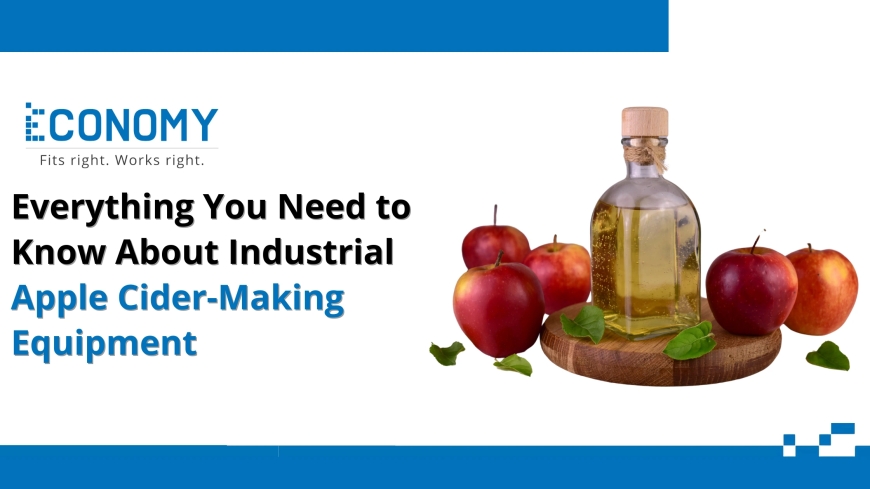Industrial Apple Cider-Making Equipment: A Comprehensive Guide
As apple cider continues to gain global popularity, industrial producers must embrace modern equipment and practices to stay competitive. From fruit processing to bottling, every step requires reliable, efficient machinery.

The Basics of Industrial Cider Production
Apple cider production has grown from a small-scale artisanal practice into a sophisticated, large-scale operation. Industrial cider-making involves carefully controlled processes, specialized machinery, and advanced technologies to ensure consistent quality, volume, and taste. With global demand for cider rising, investing in the right equipment is critical to producing a high-quality product efficiently.
Understanding the Apple Cider-Making Process
The cider-making process begins with the selection of quality applesranging from sweet to tart varietiesto achieve a balanced flavor. Apples are washed, sorted, crushed, and pressed to extract juice, which is then fermented using natural or added yeast. After fermentation, the cider is filtered, aged, carbonated (if desired), and bottled. Each step requires precision and the right tools to maintain hygiene, quality, and efficiency.
Key Stages in Cider Production
-
Sorting and Washing Removal of debris and inspection of apples.
-
Crushing and Pressing Converts apples into a juice-rich pulp.
-
Fermentation Sugars convert to alcohol with the help of yeast.
-
Filtration and Clarification Removes solids and unwanted particles.
-
Aging and Carbonation Enhances flavor profile and texture.
-
Packaging Bottling, capping, labeling, and sealing.
The Role of Equipment in Scaling Operations
Manual cider production methods are ideal for small batches, but industrial production demands efficiency, consistency, and scalability. Automated machinery reduces labor costs, increases yield, ensures product consistency, and meets regulatory standards. Modern cider-making equipment allows producers to handle thousands of liters per day without compromising on quality.
Key Equipment for Apple Cider Production
Every stage of cider production requires specific machines. Essential equipment includes:
-
Fruit Washers and Conveyors: Clean and transport apples efficiently.
-
Apple Mills/Grinders: Reduce apples into fine pulp for juice extraction.
-
Hydraulic or Belt Presses: Extract high volumes of juice from apple mash.
-
Fermentation Tanks: Stainless steel tanks with temperature control features.
-
Filtration Systems: Plate filters or cross-flow systems for clarity.
-
Carbonation Units: Infuse CO? into the cider for a sparkling effect.
-
Bottling Lines: Automatic systems for filling, sealing, and labeling.
Essential Tools and Machines
In addition to the core equipment, cider producers benefit from:
-
Pasteurizers: Ensure product safety and extend shelf life.
-
Pumps and Hoses: Facilitate fluid transfer between stages.
-
Monitoring Instruments: Measure sugar, pH, alcohol content, and temperature.
-
Cleaning-in-Place (CIP) Systems: Maintain hygiene in tanks and pipelines.
Advanced Technologies in Cider-Making
Innovation in cider-making equipment has led to smart systems integrated with sensors and IoT capabilities. These systems monitor fermentation, adjust temperature automatically, and provide real-time data for quality control. Cross-flow filtration, automation in bottling, and clean energy systems are helping producers cut costs and boost sustainability.
Choosing the Right Apple Cider Industrial Machinery
When selecting industrial apple cider making equipment, consider production volume, type of cider (still or sparkling), and level of automation. Modular systems are ideal for growing businessesthey allow expansion without major overhauls. Stainless steel components ensure durability, ease of cleaning, and resistance to corrosion.
Factors to Consider When Investing in Equipment
-
Production Capacity: Choose equipment that meets your output goals.
-
Budget and ROI: Balance between upfront cost and long-term savings.
-
Ease of Maintenance: User-friendly design and service accessibility.
-
Compliance: Ensure the equipment meets food safety and industry regulations.
-
Supplier Support: Look for manufacturers who provide training, installation, and spare parts availability.
Maintenance and Care for Industrial Equipment
Regular cleaning, calibration, and servicing of machines ensure longevity and consistent performance. Implementing a preventive maintenance plan helps avoid unexpected downtime. Always use manufacturer-recommended cleaning agents and schedule professional inspections at least once a year.
Benefits of High-Quality Cider Equipment
Investing in quality machinery leads to better juice yields, consistent fermentation, and higher production rates. It minimizes waste, reduces energy consumption, and improves hygiene. Ultimately, this enhances the final products taste, shelf stability, and market valueboosting brand reputation and customer satisfaction.
Future Trends in Apple Cider Production
Sustainability, automation, and data-driven operations are shaping the future of cider-making. Expect increased use of solar-powered equipment, AI-based quality monitoring, and modular production systems. Consumer preferences are also evolvingdemanding organic, low-sugar, and flavored cider variantsprompting manufacturers to adopt flexible, innovative machinery.
Conclusion
As apple cider continues to gain global popularity, industrial producers must embrace modern equipment and practices to stay competitive. From fruit processing to bottling, every step requires reliable, efficient machinery. By investing in the right tools, maintaining them well, and keeping up with industry trends, cider manufacturers can ensure product excellence, operational success, and long-term growth.
































